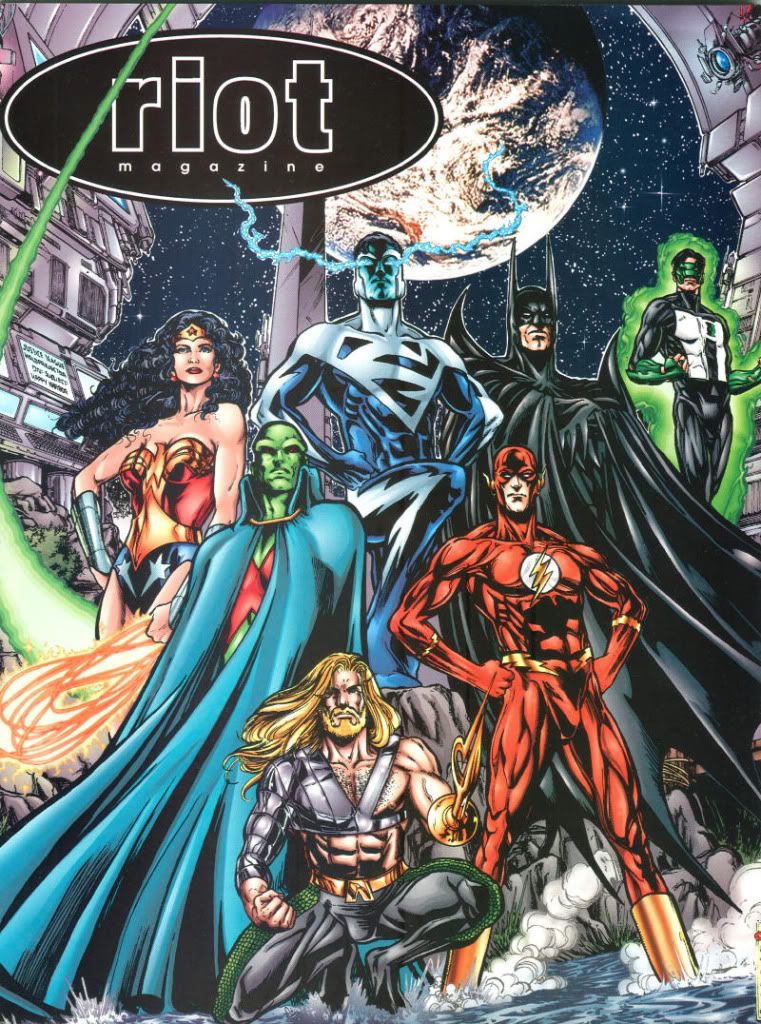
riot was a very short-lived magazine that aimed to be a hipper version of Wizard in a format more closely resembling Comic Scene. I'm not actually certain any issues were ever released to the general public, as the only one I've ever seen was this special zero issue given free to retailers as an introduction to encourage sales. All under a fantastic Phil Jimenez JLA cover and summarized:
- Editorial Mission Statement (one page)
- Propaganda- News on the upcoming Marvel Heroes Return titles, the newly founded Awesome Entertainment, and Divine Right: The Adventures of Max Faraday.(two pages)
- twenty-first CENTURYBOY (four page Grant Morrison interview)
- Where the Wild Things Are (feature on JLA/WildC.A.T.S., two pages)
- POP STAR (Matthew Sweet interview, two pages)
- Hollywood Goes To Hell (Spawn movie feature, two pages)
- Two page ad for October's riot #1, a 128 page monthly with an extended Matthew Sweet interview, a look at Duran Duran, John Waters, John Woo, Buffy, X-Files, Wonder Woman: Amazonia, and all under a new (unseen) cover by Joe Madureira on his departure from Uncanny X-Men.
- Stargazing (a two page Neil Gaiman interview concerning Stardust.
- A two page look at the Hercules/Xena animated video.
- Tools of the Revolution (toy section spotlighting Spawn movie figures, Batman and Robin, Teenage Mutant Ninja Turtles, and Toy Biz late Summer releases. The riot Hot Ten Action Figures took up an additional two pages.
- Max & Lily in "Junkie" (a one page gag strip on flea markets by Kris Dresden.)
- UK Music Report on Tellin' Stories, and reviews of the new Daft Punk, HAL (featuring Gillian Anderson,) and Mark Morrison.
- Four pages of comic reviews for Genesis #1 ("just not that great,") WildC.A.T.S #39 ("What else could you want?") Supreme #53 ("too much fun,") Wolverine #115 ("intense,") Red Rocket Seven #1 ("original,") Spawn #62 ("one of the greatest,") Spider-Man Unlimited #17 ("soap opera,") and Inferno #1 ("solid.")
- Under The Hot Lights: Alan Moore (interview where the writer bemoans the state of the industry, grim n' gritty, and everything else you'd expect. Two pages.)
riot really seemed enamored of paid sponsor Spawn, but then again, their only other ad was for DC's Genesis, so maybe there wasn't a conflict of interest after all. The most interesting portion was of course the Grant Morrison interview, where he discussed JLA and Invisibles.
Having proven itself worthy with its return to epic storylines and its acquisition of massive sales, JLA is the book to watch. But when finally cornered as to the secret of the series' success, Morrison only laughs. "The only reason sales dropped off in the past is that perhaps there wasn't a clear understanding of JLA's mythical underpinnings, which was what really gave the book its power. With JLA, you're dealing with concepts that are rooted in the mythologies of every single culture on Earth... When you look at each individual Justice Leaguer, whether it's Superman, Batman, Wonder Woman, Flash, Green Lantern, Aquaman, or even the Martian Manhunter, you can map them onto a different mythological character, and that's why they're so strong. That iconic power of the characters is what makes this book so successful. And with comics like the X-Men, you don't have that. You don't have characters so strong that they're almost gods... Superheroes are as powerful, as they are symbolic. They say so much, but even today, they have the potential to say so much more... Comics are incredibly sensitive barometers of social change. Just look at the way that Batman has reflected the culture over the years. This material has a psychological and a spiritual significance, whether we're embarrassed to admit it or not..."
"The Silver Age began when DC Comics editor Julie Schwartz and his little stable of writers revitalized the market with lively, science fiction-oriented heroes. Julie brought an adult point of view to mainstream comics, and what several of us have been talking about recently is that characters from that era, like the "Barry Allen' Flash and the "Hal Jordan' Green Lantern, were all 'grown-ups.' I read Gerard Jones' book, The Comics Book Heroes, and he pointed out that these were heroes who never fought amongst themselves; held interesting jobs; and had wives or girlfriends. They were just very together, unlike most heroes today. Even in their spare time, the Silver Age heroes just hung out reading books about science and tackling weird medicine."
"Looking at where comics are now, I also want to approach characters as adults... The last few years we've seen nothing but those tortured characters—the 'Dark Knight' Batman basically became a tortured adolescent—and what me and a few others like Mark (Millar) and Mark Waid (Flash, Kingdom Come) would like to do is bring heroes like Batman back as men. I'm talking about the Batman that I remember. The Denny O'Neil, seventies Batman with a big hairy chest, who was always kissing girls, and flying about in the Batplane all over the world..."
Though Morrison doesn't want to limit his audience to just kids—The Invisibles is definitely not a children's book—he does see the importance of bringing them back to comics. Of course, he also thinks that you'd have to be stupid not to. Working up cool ideas such as Justice League Junior—a hip and happening superhero team that would showcase younger DC characters such as Superboy, Mary Marvel and Impulse—he's setting out to attract the once prevalent, currently dwindling, younger audience, as well as attempting to safeguard the future of the industry he loves.


No comments:
Post a Comment